Blast-ripped industrial zone a hub for Chinese, foreign firms
Binhai New Area, where blasts occurred on Wednesday, is a giant logistics hub more than twice size of Hong Kong
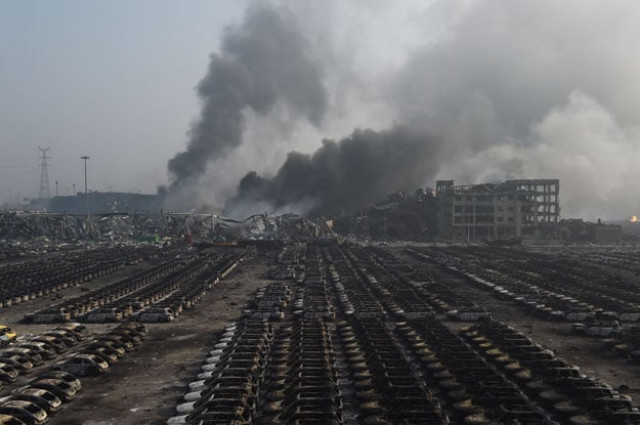
Smoke billows behind rows of burnt out Volkswagen cars at the site of a series of explosions in Tianjin, northern China on August 13, 2015. PHOTO: AFP
The Binhai New Area in northern China, where the blasts killed scores of people and injured more than 500, is a giant logistics hub more than twice the size of Hong Kong.
Read: China blast toll rises to 44
 Fires burn at the site of an explosion in Tianjin, in northern China on August 13, 2015. PHOTO: AFP
Fires burn at the site of an explosion in Tianjin, in northern China on August 13, 2015. PHOTO: AFPIt hosts auto plants, aircraft assembly lines, oil refineries and other service and production facilities, and describes itself as a "modern manufacturing and research base" on its website.
 Fire and smoke rise from the site of a series of explosions in Tianjin early on August 13, 2015. PHOTO: AFP
Fire and smoke rise from the site of a series of explosions in Tianjin early on August 13, 2015. PHOTO: AFPThe area is home to the world's second fastest supercomputer, which was shut down as a precaution after Wednesday night's huge blasts.
Read: Explosion at factory in eastern China kills 65: State media
It is also a major automobile trans-shipment point where about 10,000 imported cars were destroyed, according to the Qilu Evening News, 2,748 from German manufacturer Volkswagen and more than 1,000 built by France's Renault.
 Fire and smoke rise from the site of a series of explosions in Tianjin early on August 13, 2015. PHOTO: AFP
Fire and smoke rise from the site of a series of explosions in Tianjin early on August 13, 2015. PHOTO: AFPTianjin is a major port for northern China, handling containers amounting to more than 14 million 20-foot equivalent units last year, according to the Binhai website.
Operations at the port were "basically paralysed" by the blast, the official China Securities Journal reported.
 Smoke billows behind rows of burnt out cars at the site of a series of explosions in Tianjin, northern China on August 13, 2015. PHOTO: AFP
Smoke billows behind rows of burnt out cars at the site of a series of explosions in Tianjin, northern China on August 13, 2015. PHOTO: AFPResources giant BHP Billiton — for which China is a crucial market — said in a statement that its iron ore discharge berths were undamaged, with the closest 20 kilometres from the blast site.
 A man looks at a row of damaged cars outside a residential building near the site of a series of explosions in Tianjin, northern China on August 13, 2015. PHOTO: AFP
A man looks at a row of damaged cars outside a residential building near the site of a series of explosions in Tianjin, northern China on August 13, 2015. PHOTO: AFPBut it said that "shipments and port operations have been disrupted" by the blast and it was working with its customers "to minimise any potential impact".
Read: Three dead as 6.4 earthquake hits China's Xinjiang
Europe's Airbus also said it was assessing the effect on port operations.
 Shattered windows are seen on the facade of a residential building near the site of a series of explosions in Tianjin, northern China on August 13, 2015. PHOTO: AFP
Shattered windows are seen on the facade of a residential building near the site of a series of explosions in Tianjin, northern China on August 13, 2015. PHOTO: AFPIt has an assembly line for its popular A320 aircraft in the area and said Thursday that the blast was far from the facility and caused no immediate damage.
 Smoke rises behind damaged shipping containers and mangled cars and buildings at the site of a series of explosions in Tianjin on August 13, 2015. PHOTO: AFP
Smoke rises behind damaged shipping containers and mangled cars and buildings at the site of a series of explosions in Tianjin on August 13, 2015. PHOTO: AFP"The Airbus Tianjin site is far beyond the area of explosion. There is no impact on the employees and the facilities," it told AFP in an emailed statement. "Operations at Airbus Tianjin run normally today."
But it added: "The potential impact on logistics via Tianjin Port ... is currently under investigation."
 Smoke rises behind damaged shipping containers at the site of a series of explosions in Tianjin on August 13, 2015. PHOTO: AFP
Smoke rises behind damaged shipping containers at the site of a series of explosions in Tianjin on August 13, 2015. PHOTO: AFPJapanese auto giant Toyota has a joint venture car plant in Binhai, but an executive with the operation told AFP the factory was on summer vacation and was not affected in the explosion.
Neither Volkswagen nor Renault officials were immediately available to comment when contacted by AFP Thursday.
 A damaged warehouse is seen at the site of a series of explosions in Tianjin on August 13, 2015. PHOTO: AFP
A damaged warehouse is seen at the site of a series of explosions in Tianjin on August 13, 2015. PHOTO: AFPThe Binhai New Area covers 2,270 square kilometres (876 square miles) and has a coastline of 153 kilometres (95 miles), the website says.
It is focussed on eight main industries including aerospace and aviation, electronics and information, equipment manufacturing, petrochemical and new energy and material.
 Two men look at broken windows in a building near the site of an explosion in Tianjin, in northern China on August 13, 2015. PHOTO: AFP
Two men look at broken windows in a building near the site of an explosion in Tianjin, in northern China on August 13, 2015. PHOTO: AFPChinese supercomputer Tianhe-1A was also shut down, the official Xinhua news agency said, citing officials at the National Supercomputing Centre in Binhai.
 A man leaves his apartment after a blast destroyed all the windows near the site of a series of explosions in Tianjin, northern China on August 13, 2015. PHOTO: AFP
A man leaves his apartment after a blast destroyed all the windows near the site of a series of explosions in Tianjin, northern China on August 13, 2015. PHOTO: AFPThe machine itself was intact after the explosion and running normally, Xinhua said, but the building housing it was damaged and it was switched off due to security concerns.

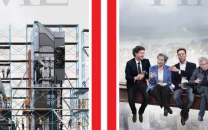
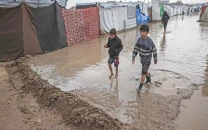
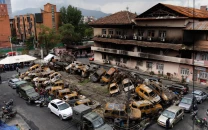






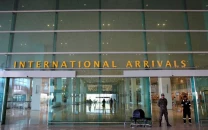








COMMENTS
Comments are moderated and generally will be posted if they are on-topic and not abusive.
For more information, please see our Comments FAQ